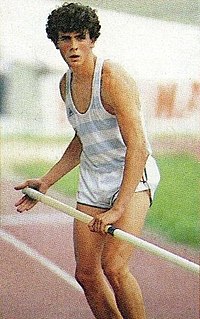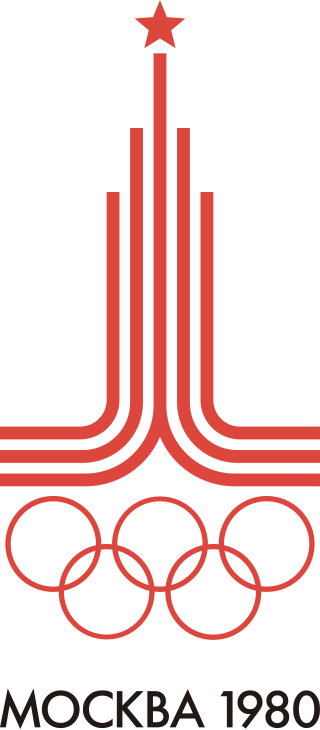
The 1980 Summer Olympics, officially known as the Games of the XXII Olympiad and officially branded as Moscow 1980, were an international multi-sport event held from 19 July to 3 August 1980 in Moscow, Soviet Union, in present-day Russia. The games were the first to be staged in an Eastern Bloc country, as well as the first Olympic Games and only Summer Olympics to be held in a Slavic language-speaking country. They were also the only Summer Olympic Games to be held in a socialist country until the 2008 Summer Olympics held in China. These were the final Olympic Games under the IOC Presidency of Michael Morris, 3rd Baron Killanin before he was succeeded by Juan Antonio Samaranch, a Spaniard, shortly afterwards.
The men's pole vault competition at the 2004 Summer Olympics in Athens was held at the Olympic Stadium on 25–27 August. Thirty-nine athletes from 25 nations competed. The event was won by Timothy Mack of the United States, the nation's 18th victory in the men's pole vault. Toby Stevenson took silver, making it the second consecutive Games that Americans finished 1st and 2nd. Giuseppe Gibilisco's bronze was Italy's first medal in the event.

Władysław Kozakiewicz is a Lithuanian-born retired Polish athlete who specialised in the pole vault. He is best known for winning the gold medal at the 1980 Summer Olympics in Moscow and the bras d'honneur gesture which he showed to the hostile Soviet crowd. In Poland, where the gesture was viewed as a symbol of resistance against Soviet dominance, it became known as "Kozakiewicz's gesture". In addition, he won several medals at continental level, won two Summer Universiades and broke the pole vault world record three times, twice outdoors and once indoors. He is also a ten-time Polish champion.

Thierry Vigneron is a retired French pole vaulter. In the 1980s, he was among the world's leading pole vaulters. He broke the world record in the event four times and was the last man to hold the world record before Sergey Bubka, who would hold on to it almost 30 years until February 2014.

Pierre Quinon was a pole vaulter from France who won the 1984 Olympic Games pole vault gold medal and held the pole vault outdoor world record for just four days in the summer of 1983.
Michael Scott Tully is an American pole vaulter. He represented the United States twice in the Olympics, earning a silver in 1984, and held the American pole vault record from 1984 to 1985.
The men's pole vault at the 1988 Summer Olympics in Seoul, South Korea had an entry list of 21 competitors from 13 nations, with two qualifying groups before the final (15) took place on Wednesday September 28, 1988. The maximum number of athletes per nation had been set at 3 since the 1930 Olympic Congress.
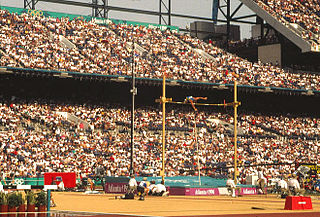
The men's pole vault was an event at the 1996 Summer Olympics in Atlanta, Georgia. Thirty-seven athletes from 24 nations competed. The maximum number of athletes per nation had been set at 3 since the 1930 Olympic Congress. The event was won by Jean Galfione of France, the nation's second victory in the event. Igor Trandenkov took silver, the first medal for Russia in the pole vault in its first appearance as a separate delegation. Similarly, Andrei Tivontchik's bronze was the first for reunified Germany, though both East Germany and West Germany as well as the Unified Team of Germany had previously won medals.

The Men's Pole Vault was an event at the 1992 Summer Olympics in Barcelona, Spain. There were a total number of 34 participating athletes from 23 nations. The maximum number of athletes per nation had been set at 3 since the 1930 Olympic Congress. The qualification mark was set at 5.60 metres.

The men's high jump event at the 1984 Summer Olympics in Los Angeles, California, was held at the Los Angeles Memorial Coliseum on 10–11 August 1984. Thirty athletes from 20 nations competed. The maximum number of athletes per nation had been set at 3 since the 1930 Olympic Congress. The event was won by Dietmar Mögenburg of West Germany, the nation's first victory in the men's high jump. Patrik Sjöberg's silver was Sweden's first medal in the event since 1920. Zhu Jianhua won bronze in the People's Republic of China's first appearance. The United States, which had made the podium in each of the 18 editions of the high jump before the 1980 boycott, now missed the podium for the first time in which the country competed, as Dwight Stones in fourth place fell just short of becoming the first man to earn three medals in the event.
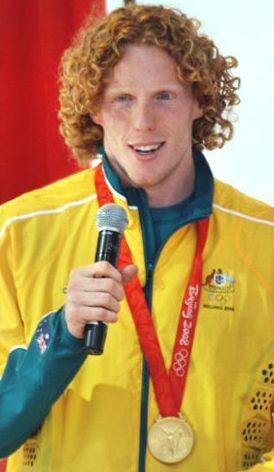
The men's pole vault at the 2008 Summer Olympics took place on 20 and 22 August at the Beijing National Stadium. Thirty-eight athletes from 25 nations competed. The event was won by Steven Hooker of Australia, the nation's first medal in the men's pole vault. Russia took its third medal of the four Games since competing independently; including Russian vaulters for the Soviet Union and Unified Team, Russians had taken six medals in the last six Games. The bronze medal initially went to Denys Yurchenko of Ukraine, but was later stripped from him for doping offenses and reassigned to fourth-place finisher Derek Miles of the United States.

The men's high jump event at the 1980 Summer Olympics in Moscow, Soviet Union, had an entry list of 30 competitors from 19 nations. The maximum number of athletes per nation had been set at 3 since the 1930 Olympic Congress. The final was held on Friday 1 August 1980. The event was won by Gerd Wessig of East Germany, the first gold medal by a German athlete in the men's high jump. It was also the first time a world record in the high jump had been set at the Olympics. Jörg Freimuth took bronze, making East Germany the third nation to have two medalists in the event in the same Games. Defending champion Jacek Wszoła of Poland took silver, becoming the fourth man to win two high jump medals and matching Valeriy Brumel for best results at one gold and one silver. Through the 2016 Games, Wszoła, Brumel, and Javier Sotomayor remain the most successful Olympic men's high jumpers; no high jumper has won two gold medals, or one gold and two silvers. Due at least in part to the American-led boycott, the United States' streak of making the podium in every Olympic men's high jump event to date ended.

The men's pole vault event at the 1980 Summer Olympics in Moscow, Soviet Union had an entry list of 19 competitors from 10 nations. The maximum number of athletes per nation had been set at 3 since the 1930 Olympic Congress. The final was held on Wednesday July 30, 1980. The top twelve and ties and all those clearing 5.40 metres advanced to the final. The event was won by Władysław Kozakiewicz of Poland, the nation's second consecutive victory in the men's pole vault. His countryman Tadeusz Ślusarski, who had won the event four years earlier, became the fifth man to earn two medals in the event when he finished in a tie for silver. The other silver went to Konstantin Volkov and was the Soviet Union's first pole vault medal.

The men's pole vault event at the 2000 Summer Olympics as part of the athletics program was held at the Olympic Stadium on Wednesday, 27 September, and Friday, 29 September. Thirty-six athletes from 22 nations competed. The maximum number of athletes per nation had been set at 3 since the 1930 Olympic Congress. The event was won by Nick Hysong of the United States, the nation's first victory in the event since its 16-Games streak ended. The American team also took silver, as Lawrence Johnson finished second. Russia's Maksim Tarasov became the seventh man to win multiple pole vault medals, and the second to do so under two different flags, adding a bronze to his 1992 gold.

The men's pole vault was a competition at the 2012 Summer Olympics in London, United Kingdom. The event was held at the Olympic Stadium on 8–10 August. Thirty-two athletes from 23 nations competed. The event was won by Renaud Lavillenie of France, the nation's first victory in the event since 1996 and third overall. Björn Otto and Raphael Holzdeppe of Germany took silver and bronze, respectively; like France, it was the first time since 1996 that Germany reached the men's pole vault podium.
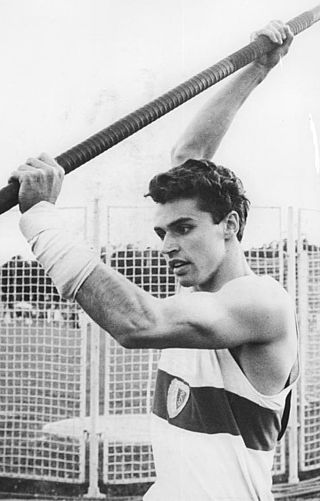
The men's pole vault field event at the 1972 Olympic Games took place on September 1 & 2. Twenty-one athletes from 12 nations competed. The maximum number of athletes per nation had been set at 3 since the 1930 Olympic Congress. The event was won by Wolfgang Nordwig of East Germany, the first non-American to win the event. Nordwig and silver medalist Bob Seagren were the third and fourth men to win multiple medals in the event.

The men's pole vault competition featured in the athletics programme at the 1976 Summer Olympics and was held at the Olympic Stadium in Montréal on 24 and 26 July. Twenty-seven athletes from 13 nations competed. The maximum number of athletes per nation had been set at 3 since the 1930 Olympic Congress.

The men's pole vault was one of four men's jumping events on the athletics program at the 1968 Summer Olympics. The competition had two rounds, qualifying and a final, which were held on 14 and 16 October respectively at the Estadio Olímpico Universitario in Mexico City. Twenty-three athletes from 15 nations competed. The maximum number of athletes per nation had been set at 3 since the 1930 Olympic Congress. The event was won by Bob Seagren of the United States, the nation's 16th consecutive victory in the men's pole vault. Claus Schiprowski of West Germany took silver, while Wolfgang Nordwig of East Germany took bronze—the first medals for each of those nations as separate teams, though two West German vaulters had earned silver and bronze for the United Team of Germany in 1964.
The men's pole vault competition at the 2016 Summer Olympics in Rio de Janeiro, Brazil. The event was held at the Olympic Stadium between 13–15 August. Thirty-one athletes from 16 nations competed. Thiago Braz da Silva of Brazil won the gold medal, the nation's first medal in the men's pole vault. Renaud Lavillenie of France was unable to successfully defend his 2012 gold, but became the seventh man to win two medals with silver this time. Sam Kendricks's bronze returned the United States to the podium after a one-Games absence.

The men's pole vault event at the 2020 Summer Olympics took place between 31 July and 3 August 2021 at the Japan National Stadium. 29 athletes from 18 nations competed. Armand Duplantis of Sweden won gold, with Christopher Nilsen of the United States earning silver and Thiago Braz of Brazil taking bronze. It was Sweden's first victory in the event and first medal of any color in the men's pole vault since 1952. Braz, who had won in 2016, became the ninth man to earn multiple medals in the pole vault.
